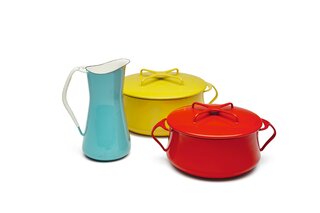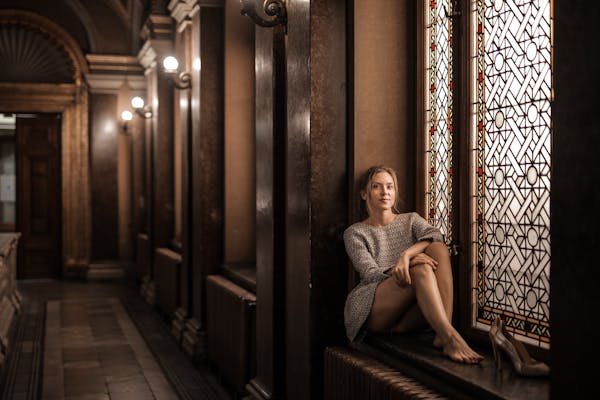The Story of Scandinavian Design Isn’t What You Think It Is


At the Los Angeles County Museum of Art, a new exhibition featuring Nordic design from the previous century includes dozens of objects you likely already know and love: a Finn Juhl chair, sleek and modernist; 1960s Marimekko textiles with bright florals; and Alvar Aalto’s glass Iittala vase, with its sinuous contours. There are also late 19th- and early 20th-century works that, predating midcentury modernism, are more ornate and likely less familiar: wooden chairs and iron punch bowls inscribed with lace patterns, vikings, and dragons, and hand-woven tapestries and elaborate jewelry. And finally, the show includes more than a handful of presumably American items you might be surprised to find there at all, like Lego sets, Eames chairs, and Fiskars scissors.
The Los Angeles County Museum of Art’s latest exhibit features works from 1890-1980 by Scandinavian designers and their American counterparts. The museum commissioned Barbara Bestor Architects for show’s colorful design.
At its heart, Scandinavian Design and the United States, 1890–1980, on view at LACMA through February 5 of 2023, is an exhibition focused on the immigrant designers and craftspeople from Denmark, Sweden, Finland, Norway, and Iceland who “played an enormous role in shaping American design,” says LACMA’s Bobbye Tigerman, who cocurated the exhibit with Monica Obniski of the Milwaukee Art Museum.
The exhibition, designed by Los Angeles architect Barbara Bestor, serves as a follow up to Tigerman’s book of the same name, released in 2020, which is packed with examples of Scandinavian design influences on America. Charles and Ray Eames, for example, owe some credit to Finnish architect Eliel Saarinen, who, like many Nordic immigrants, arrived in the American midwest early in the twentieth century. Saarinen designed both the campus and academia of Cranbrook Academy of Art outside Detroit, Michigan, inviting other Nordic immigrants, including ceramicist Maija Grotell and weaver Marianne Strengell, to join the faculty. The school eventually became the incubator of some of the most acclaimed American designers, including the Eameses, Florence Knoll, and many others.
Marimekko textiles are a few of the familiar favorites included in the exhibition.
A collection of midcentury-modern seating that includes Eero Saarinen’s Tulip chair and an Eames Molded Plastic armchair highlights the dialogue that was happening between American and Nordic designers.
The exhibition also highlights moments when the United States mutually influenced Nordic designers. The formica-and-walnut midcentury desk that greets visitors at the entrance of the museum is a 1952 design by Greta Magnusson Grossman, a Swedish designer and architect who immigrated to California in 1940. “With this desk, she’s using a traditional cabinet-making wood with an American production technique,” Tigerman says. “To me, it’s a really nice marriage of her Scandinavian and American experiences.”
Further into the exhibition, there’s a vintage set from Danish brand Lego, which arrived in the United States just in time for the Christmas of 1961. “It’s a fun example of how a Scandinavian product captured the excitement and the fascination of an American audience,” Tigerman says. By that point in the twentieth century, Americans were huge fans of “Scandinavian design” as a marketing catchphrase, however incomplete our vision of Scandinavia might have been.
For Bobbye Tigerman, one of the exhibition’s cocurators, the formica-and-walnut Greta Grossman desk on the right is “a really nice marriage of the designer’s Scandinavian and American experiences.”
American couple Martha and Ted Nierenberg founded the brand Dansk in the garage of their Great Neck, New York, home in 1954. Says Tigerman, they were “trading on Scandinavian design’s associations with being high-quality, modern, and efficient.” They hired Danish designer Jens H. Quistgaard to create these Købenstyle casserole dishes and pitcher in 1955.
This Viking boat centerpiece was designed in 1905 by Rhode Island–based Gorham Manufacturing Company during a period known as Viking revival. The movement gained popularity in the 19th century as WASPs pitted Leif Erikson, a Norse explorer, against the Roman Catholics’ Christopher Columbus for the title of discoverer of America.
Hand-painted Dala horses like these, originally from the rural Dalarna region of Sweden, are popular in the midwest as keepsakes of Scandinavian heritage.
“While we use the phrase ‘Scandinavian design’ to capitalize on the term’s continuing currency, we acknowledge its shortcomings and limitations,” the exhibition catalog reads, pointing out the ongoing generalizations made about this region of the world. A lot of them can be attributed to marketing strategies after World War II, Tigerman explains: As the midcentury American economy boomed and the Nordic countries wanted to ally themselves with the U.S. side of the Cold War, advertisers on both ends of the Atlantic sold “Scandinavian” as a single, homogenous style, characterized by simple, organic, well-made forms. “Exhibitions of Scandinavian design that came to America tried to associate these objects not just with modernism and natural materials, but with freedom and democracy,” Tigerman says.
In reality, Scandinavia comprises three countries with very different cultures and economies with their own highs and lows. (And Finland is actually not a Scandinavian country, but a Nordic one.) But for the American palate, “Scandinavian design” was an ideal fantasy. Exotic but not too exotic, it found immense popularity in the pages of House Beautiful and American homes, so much so that in the mid ’50s, a New York couple founded a brand of colorful kitchenware and called it Dansk—the Danish word for Danish.
The late Howard Smith was a Black artist from Philadelphia who moved to Finland in 1962 and decided to stay. This is a 1978 example from his successful run as a textile designer for the Finnish Vallila silk company.
This is a 1951 sketch by Swedish textile artist Marianne Richter of one of her tapestries that eventually hung in the United Nations Economic and Social Council Chamber.
The show ends in the 1980s, where under a new globalized world order, Italian and Japanese design rose to prominence while the fantasy of Scandinavian design began to fade away, although not completely. These days, designs from Nordic countries are commonplace, characterized by minimalism, more subtle colors, and the coziness of hygge. But like so many other immigrant groups in the history of the U.S., the contributions Nordic people made to the country through the early and mid 1900s remain indelible to American culture today.
Kaj Franck, the Finnish designer who created these goblets for Nuutajärvi Glassworks in 1968, is one of many Nordic craftspeople who were influenced by the United States. In 1956, he toured the United States on a Fulbright scholarship, starting with RISD and ending at UCLA.








